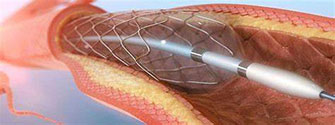
A coronary angiography is an X-ray exam of the blood vessels of the heart. It is performed to diagnose heart conditions. Your cardiologist may recommend a coronary angiography if you are experiencing symptoms of coronary artery disease, such as chest pain, or to identify reasons for pain in the chest, neck or arm. A coronary angiography may also be necessary if you have a congenital heart defect, or experience heart failure, a chest injury, other blood vessel problems, or a heart valve problem that must be treated with surgery.
A coronary angiography is performed in the Cath Lab of a hospital. The procedure is typically scheduled during morning hours.
Before the Procedure
Follow these guidelines prior to your coronary angiography:
- Avoid drinking or eating after midnight.
- Talk with your cardiologist about what medications you should or shouldn’t take on the morning of the procedure.
- If you are diabetic, speak with your cardiologist about whether or not you should take insulin or your other medications on the day of the procedure.
During the Procedure
During the procedure, you’ll be lying on your back on an X-ray table. A catheter (small tube) is inserted into a blood vessel in the arm or groin area. The tube is carefully threaded to your heart or the coronary arteries. You should not feel any pain or discomfort as the catheter is moving through your body, but inform your cardiologist if you are experiencing any discomfort.
Once the catheter is in place, a dye is injected into it. This dye is easily seen on the X-ray images, and as it moves through the blood vessels, blockages are easily identified. The procedure typically lasts an hour.
After the Procedure
After the procedure, the catheter will be removed, and you’ll be taken to a recovery area for observation. Once you become stable, you’ll be placed in a room, where you will be closely monitored. You must lie flat for several hours to prevent bleeding. Pressure may be applied to the entry site to promote healing and prevent bleeding.
You may be permitted to go home the day of the procedure or you may have to stay in the hospital for a day or so. Drinking lots of fluids will help flush the dye out of your body. Your cardiologist will inform you when you can resume your normal daily activities.
Contact your physician if:
- You began having chest pain or shortness of breath
- You feel weak or faint
- You notice signs of infection, such as fever, redness or drainage
- You begin experiencing severe pain or discomfort at the catheter site
- You notice bleeding, swelling or new bruising in the area where the catheter was inserted
Your Results
Depending on your results, your cardiologist can assess what treatment is most beneficial for you, as well as the extent of your heart condition, and how it can affect your health. You should receive results the day of the procedure.
Risks
Major complications are rare. Potential risks include:
- Stroke
- Heart attack
- Kidney damage
- Infection
- Irregular heart rhythms
- Allergic reaction to the dye or medicine utilized throughout the procedure
Remember, your cardiologist has recommended this procedure because the benefits of treating your heart condition far outweigh the risks.